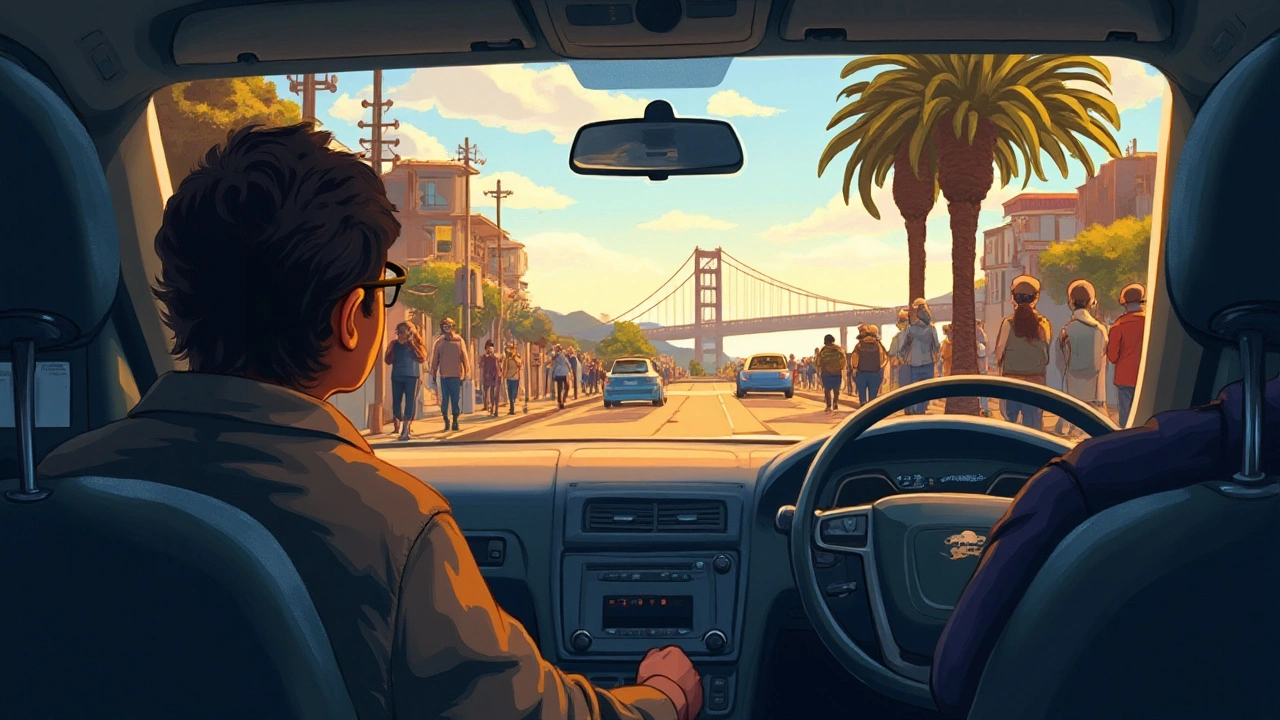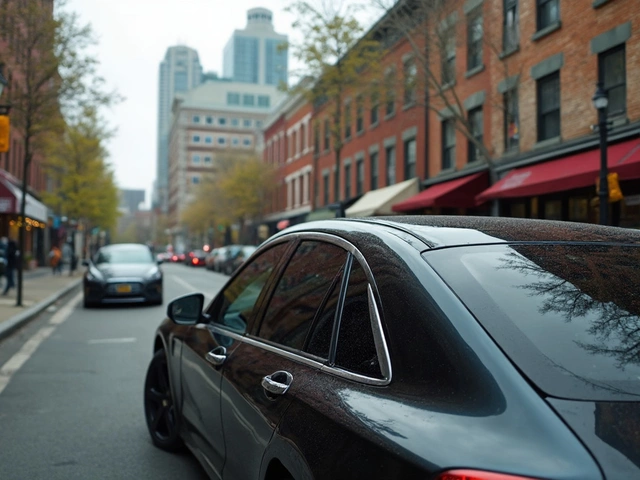Window tinting not only enhances the aesthetic appeal of your vehicle but also provides practical benefits like UV protection and privacy. However, the rules regarding tinting can be confusing, especially in states like California, where regulations are stricter than in many other areas. If you're considering a 20% window tint, it's crucial to understand the laws and how they apply to ensure you're not unknowingly breaking them.
In this article, we'll delve into what 20% tint means, how it fits within California's legal framework, and the potential penalties for not adhering to these laws. We'll also explore if there are any exceptions to the rule and provide some handy tips for ensuring you choose a legal yet effective tint for your vehicle. Armed with this knowledge, you can make informed decisions about your car's window tinting and ensure you're getting the most out of it without running afoul of the law.
- Understanding Window Tint Percentage
- California Tint Laws Explained
- Exceptions to the Tint Law
- Consequences of Illegal Tint
- Tips for Choosing Legal Tint
- The Benefits of Window Tinting
Understanding Window Tint Percentage
Before discussing whether a 20% window tint is legal, it is essential to first understand what the tint percentage actually represents. When we talk about tint percentages, we are referring to the amount of visible light that the tint film allows to pass through your car windows. Specifically, a 20% tint means that only 20% of the visible light can penetrate through the window, blocking out 80% of the light. This determines the level of darkness of the window film, affecting both aesthetics and functionality, such as privacy and sun protection.
The window tint percentage is also known as Visible Light Transmission or VLT. VLT is crucial because it directly impacts the visibility for both the driver and those on the outside looking in. A lower percentage, like 20%, creates a darker film which might reduce glare and visibility from the outside, adding an extra degree of privacy. However, it can also reduce the driver's ability to see outside clearly, especially under adverse weather conditions. This is where the balance must be found between the aesthetic appeal and functional advantage, and the legal requirements of the region you are driving in.
Each vehicle window can have a different VLT requirement depending on the state’s laws for that particular window’s position — such as front windshield, side windows, or rear window. Drivers and car enthusiasts may prefer darker tints for privacy or aesthetics, but it is critical to ensure these preferences align with local legal standards, which can vary significantly from state to state in the U.S. As such, understanding the specific percentages allows car owners to better align their choices with legal standards while optimizing the performance and appeal of their vehicles.
Interestingly, window tint technologies have advanced over the years, offering more options to consumers. Modern films can provide high performance with minimal VLT reduction, which helps in complying with the legal requirements while enhancing the car's comfort and energy efficiency. According to the International Window Film Association, these advancements also aid in UV protection and can even offer shatter resistance.
"Modern window tints can block up to 99% of harmful UV rays," says John Schumacher, a prominent industry expert. "This not only protects the car's interior but also offers significant health benefits."When investing in window tinting, understanding these technical aspects can lead you to make more informed and beneficial decisions.
Now that we've covered the VLT and its importance, the next step usually involves knowing the legal thresholds set by state laws, like those in California. Each state has its unique window tinting standards, frequently updated to address visibility, safety, and law enforcement discernibility. Being aware of your current state laws prevents potential hassles and fines down the road. In places where the sun is intense, like California, window tinting is not only a stylistic choice, it becomes a necessity that balances legal allowance with commonplace practicality.
California Tint Laws Explained
California's window tinting regulations are among the strictest in the United States, primarily dictated by the safety concerns and the sunny climate in the region. Understanding the tint laws here is essential for any vehicle owner contemplating tinting, as the distinctions are not always straightforward. As of 2024, the law allows a certain percentage of tint, focusing primarily on the balance between UV protection and visibility for road safety. The front side windows must let in more light, with a minimum of 70% visible light transmission (VLT). This means that only up to 30% of the window can be shaded or darkened. Driving with windows darker than this limit can lead to hefty fines, as strict enforcement remains a key priority for state authorities. This is distinctly different from the back side windows and rear windshield, which can be darker, provided the vehicle has right and left external mirrors.
A pivotal aspect of California's tint laws is understanding how it integrates with federal regulations, particularly concerning medical exemptions. For individuals with specific medical conditions, additional UV protection might be necessary, granting them the right to darker tints. This requires certification from a licensed physician indicating the medical need. Additionally, for law enforcement, the California tint laws ensure officers can have clear visibility into vehicles, a critical requirement for safety checks and road security operations. Violations can lead to not only fines but also the requirement to remove or adjust the tint to comply with state mandates.
Given the state's commitment to environmental standards, there's also interest in promoting tints that effectively conserve energy by reducing the need for air conditioning. While compliance is essential, selecting the correct tint can contribute to better fuel efficiency. As an interesting note, the California Department of Motor Vehicles periodically updates these regulations to reflect any new technological advancements in tinting technology or changes in policy priorities. Staying informed about these updates is crucial, particularly for enthusiasts keen on maintaining aesthetic appeal along with functionality.
According to a recent interview with John B. Pritchett, an automotive expert from the California Highway Patrol, "Understanding the nuances of California tint laws is crucial, as they are designed not only for driver safety but also to ensure effective law enforcement."
These laws are not just static; as technology and safety priorities evolve, so do the regulations, prompting car owners to frequently check the latest guidelines. Many drivers mistakenly think that rules for factory-tinted windows are applicable to aftermarket tints, which isn't the case, and this is a common pitfall. The factory-installed tints already meet specific regulations and do not require additional certification, but aftermarket films must be scrutinized and certified by the installer to assert compliance. Thus, when in doubt, consulting with a professional installer familiar with California's policies can lead to more informed decision-making.

Exceptions to the Tint Law
California's window tinting laws are among the strictest in the country, but they are not without exceptions. These exemptions are worth understanding as they can allow certain individuals to use darker tints legally. One common exception pertains to medical conditions that are exacerbated by sun exposure. If you have a medical need, the state allows you to apply for an exemption with appropriate documentation from a licensed physician. Employers might also provide documentation if the tint is essential for specific occupational duties, highlighting the flexibility within the broader legislative framework.
An interesting facet of this exemption is how California Vehicle Code Section 26708 allows these medical exceptions. The state recognizes conditions like lupus, melanoma, or other photophobic conditions, and it permits the use of tint films that offer more protection. These patients must carry a certificate or letter from their physician, which should be readily available should any questions arise while out on the road.
"Many people are unaware of these exceptions," says auto industry expert John Carmichael, "It's all about knowing your rights and having the right documentation on hand."
Moreover, vehicles such as SUVs and vans often have different rules. The back windows of these vehicles can sometimes have darker tints compared to passenger cars. Owners should, however, remember that at least two side mirrors are required on any vehicle with tinted rear windows for safety visibility. This distinction is made because the regulation aims to ensure driver safety while accommodating the enhanced utility and aesthetic preferences for certain vehicle types. Without such adjustments, everyone, regardless of needs, would be bound by the same restrictions, potentially negating the personalized utility vehicles can provide.
Enforcement of these laws can be quite strict, especially in more populated urban zones where traffic officers might disproportionately encounter violations. It is crucial for drivers to adhere closely to these rules to avoid penalties. If you're thinking of exploiting the exceptions, remember to consult with the California Department of Motor Vehicles and perhaps a legal expert to ensure compliance. Always have correctly filed paperwork to support your exemption claim; this tiny step can save a significant headache later on.
Consequences of Illegal Tint
Navigating the world of window tinting can feel like stepping into a minefield of legislation, particularly in places like California where the laws are both strict and detailed. Getting it wrong is more than just a minor inconvenience; it can lead to real legal trouble. If you're caught driving with a window tint that doesn't comply with California's regulations, you might be ticketed. The method of enforcement can vary by county, as different jurisdictions apply the law with different levels of strictness. Typically, an officer may pull you over for visible tint violation, and issue a fix-it ticket. This type of ticket generally comes with a fine and a requirement that you correct the issue by a certain date. If the violation is not rectified in a timely manner, you may face heftier penalties.
The fines for illegal tint in California can range, but they usually start around $25 for a basic fix-it ticket. What many people don't realize is the cumulative effect of repeatedly ignoring these tickets. Once your vehicle is flagged, any subsequent violation can lead to considerably higher fines. These can include costs for traffic violations that go beyond the initial fine if additional offenses accrue. The irritation of dealing with multiple fines is compounded by the inconvenience of being pulled over, possibly at inopportune times, leading to delays in your daily schedule. It's a reminder that abiding by the law can be simpler than dealing with its repercussions.
Another significant impact of having illegal tint comes into play if you're involved in a collision. Insurance companies may use non-compliance with state laws as grounds to contest claims or reduce settlements. This can create an all-too-common scenario where you are left carrying the financial burden of an accident, potentially costing you far more than the price of tint removal or replacement. It’s not only about the immediate legal consequences but also the longer-term financial implications of skirting around tint laws.
For businesses, particularly those using company-owned vehicles, adhering to tint laws becomes even more crucial. An illegal tint infraction on a company car can damage corporate image, drawing negative attention from both the public and regulatory bodies. Firms often have policies in place to ensure their fleet is compliant with local laws, not only to avoid fines but also to affirm their commitment to ethical and lawful practices. If you are uncertain about compliance, most local tinting shops provide guidelines or consultations to help clients meet legal standards. They often know the intricacies of state laws and can guide you along a safer path.
"Understanding local tint laws and fully complying with them isn't just about avoiding fines, it's about maintaining a responsible presence on the road. " – Traffic Regulation Expert
For those passionate about automotive customization, it's still possible to achieve the desired look while staying within legal parameters. Consulting with professionals who understand both the aesthetic and legal aspects of window tinting can offer solutions that respect state laws. This prevents unwelcome surprises down the road and ensures that your car not only looks its best but operates legally. If you're aiming for a specific appearance, communicating this vision to a professional can lead to safer, law-abiding alternatives.

Tips for Choosing Legal Tint
Choosing the right window tint for your vehicle goes beyond just picking a shade that looks good; you must also adhere to legal standards, particularly in a state like California, renowned for its detailed tint regulations. Before getting started, familiarize yourself with the term Visible Light Transmission (VLT), which denotes the amount of light passing through the car windows. Understanding this helps ensure you're within legal limits, as California mandates specific VLT percentages for different windows.
For instance, in California, the front side windows must allow more than 70% of light in, which means darker tints like 20% are generally not permissible for these windows. Conversely, there are no restrictions on how dark the rear and back windows can be, provided the vehicle has side mirrors offering a view behind. Before deciding, make sure to scrutinize this requirement because the consequences of overlooking them can lead to fines and orders to remove illegal tints.
Another critical factor to consider is the purpose of the tint. Is it for enhanced privacy, UV protection, glare reduction, or aesthetic value? Tints designed for blocking UV rays often promote health benefits by reducing the penetration of harmful UV radiation, a key feature to consider especially for car owners in sunny regions like California. In fact, a good UV tint can reject up to 99% of UV rays while keeping the interior cooler and more comfortable.
As the renowned automotive specialist James Blaine advises, "A well-chosen tint not only respects legal standards but also significantly enhances the vehicle's comfort and longevity."
When arranging to have your car tinted, always inquire and confirm with certified professionals who are well-versed in California's tint laws. They can guide you on permissible materials and application techniques. Certified professionals usually provide a tint compliance certificate, a useful document to have in case of any potential dispute with law enforcement. Furthermore, ask if they guarantee their work, which can provide peace of mind knowing that if the tint peels or doesn’t adhere properly, they’ll take care of it.
It's also wise to verify if there are any exemptions that might apply to you. For instance, California law allows special exemptions for those with a certified medical reason, allowing the use of darker tints on the front windows than typically permitted. To qualify for such an exemption, you need a documented proof from a healthcare provider, and then arrange for the vehicle’s tinting accordingly. This is a reminder to check eligibility criteria thoroughly to avoid any unwelcome surprises.
As you make your choice, don’t overlook the aesthetic aspect as well. Car color and design can play a significant role in tint selection. Sometimes, opting for a lighter tint that complements the vehicle’s color can yield better visual results while staying legal. It's about striking a balance between functionality, aesthetics, and compliance, ensuring your vehicle looks good, serves its purpose, and adheres to the California tint laws.
In summary, selecting the right tint involves understanding legal limits, evaluating your needs, and working with qualified professionals. By taking these steps, you’ll not only enjoy the benefits of window tinting but also steer clear of potential penalties.
The Benefits of Window Tinting
When considering improvements for your vehicle, window tinting offers more than just a sleek look. The advantages tinting can bring are numerous, turning a simple aesthetic enhancement into a wise practical investment. One notable benefit of window tinting is its ability to significantly reduce UV exposure. Tinting can block up to 99% of harmful ultraviolet rays, which are known to cause skin damage and increase the risk of skin cancer. Protecting your skin during those regular drives around town or on long road trips is something you may overlook until it becomes essential, and window tinting provides an understated, yet effective shield.
But it's not just about personal health. Tinting also helps safeguard the interior of your vehicle. Prolonged exposure to sunlight can fade upholstery, crack dashboards, and deteriorate materials. By preventing this, window tinting extends the life and maintains the value of your car’s interior, which is especially appealing when considering resale value. Additionally, tinted windows can reduce glare from the sun and headlights at night, contributing to a safer driving experience, as it lessens driver fatigue and increases visibility. The right amount of tinting strikes a balance between shading the interior and maintaining enough visibility to safely navigate city streets and highways alike.
There's also energy efficiency to consider. Especially during hot summer months, window tinting can minimize the heat entering the vehicle, thus reducing the reliance on air conditioning systems. This doesn't just improve passenger comfort; it also helps with fuel efficiency. A study conducted by the International Window Film Association found that cars with window tinting used up to 3% less fuel due to diminished AC usage.
Privacy is yet another advantage that comes with window tinting. It limits the view from the outside while you and your belongings remain hidden from prying eyes, which is an added layer of security against theft. This can be particularly beneficial for those who often leave valuables in their vehicles or for anyone simply desiring more privacy on the road.
Towards the breadth of benefits, it's also crucial to acknowledge the lesser-known fact that window tinting can offer additional safety during an accident. The film can hold shattered glass together, preventing shards from scattering upon impact. This feature reduces the likelihood of injuries from flying glass, offering a small yet critical advantage in cases of collisions or break-ins.
All these aspects combined make window tinting a compelling option for those looking to protect their investment while enjoying a more comfortable and safer driving experience. As Mark Russo, an automotive design expert, once said,
The beauty of tinting is that it's not just about styling; it's a fusion of form and function that offers a multitude of benefits.Whether you're focused on health, cost savings, or simply want to enhance your vehicle's appearance, window tinting emerges as a smart choice for many car owners.




